Topic: The concept and content of the application in preschool.
Application - from the Latin word "application" - laying.
It originated in the 17th century.
A way to create artistic images from various shapes, cut from any material and pasted or sewn onto the appropriate background.
Different materials are used: leather, felt, cloth, birch bark, fur, fabric, straw, paper. Various equipment is available for pre-school children: crushing, rolling, different types of cutting (cutting in a straight line to obtain geometric shapes - squares, rectangles; cutting corners in a straight line to obtain a trapezium; cutting corners in a round line to obtain circles, ovals; cutting through the office, silhouette cutting; multi-layer cutting); cutting off, weaving.
Application is the easiest and most affordable way for children to create artwork that preserves the realistic basis of the image itself;
This is a didactic tool for the development of spatial thinking, fine motor skills of the hand, therefore, the development of speech and intelligence.
A lesson that generates the ability to listen, understand and follow instructions, perform sequential actions, coordinate the work of the hands and eyes.
The application uses a different technique of attaching parts to the base (cardboard, fabric): sticking (the entire plane of the part or part of it) and sewing. Both are available to children.
The child needs to master not only special, but general labor skills: set the task, select the necessary materials and means for its implementation, plan the progress of work, monitor and evaluate the results.
Throughout preschool childhood, this type of work becomes more complex and enriched, its content becomes fuller and deeper:
a) decorative patterns become more diverse and more complex; subjects and subjects depicted in an applicative manner;
b) the material used becomes more diverse;
c) the technique of performance becomes more varied and more complex, children can transfer the technique of work learned on one material to another, taking into account the peculiarities of the new material;
d) the works are becoming more expressive due to the combination of the material and the variety of the technique of execution, enriching the colors and compositional solutions.
Application contributes to:
Formation in children of a certain knowledge, development of skills, development of skills and personality education;
The assimilation of knowledge about the color, structure of objects of their size, plane shape and composition;
Learning about symmetry and asymmetry;
Development of orientation in space and on a limited surface, small muscles of the hands.
Types of application
Object, Story, Landscape, Decorative
Teaching children the application, the teacher decides the following. common tasks :
1. Forms the ability to make a decorative pattern of various geometric shapes and plant (leaf, flower) parts, placing them in a certain rhythm on a cardboard or fabric base of various shapes.
2. Forms the ability to make an image of an object from separate parts; portray the plot.
3. Learn to master various techniques for obtaining parts for the application of different materials.
4. Forms a sense of color, learns to recognize the primary colors and their shades, to master the ability to make harmonious color combinations.
5. Forms a sense of form, proportion, composition.
Cutting methods
Cutting regular geometric shapes.
Cutting paper folded in half. Used for cutting objects of symmetrical shapes (leaves, flowers).
Cutting out of paper folded several times. For cutting items of more complex symmetrical shape.
Cutting out of paper, folded accordion. For cutting several identical shapes and for garlands.
Cutting in parts.
Cutting over the office.
Breaking the paper.
The second younger group
To acquaint children with different properties of paper as a material;
To acquaint with the techniques of laying out and sticking ready-made forms on a sheet of paper;
Learn to navigate on a sheet of paper;
To acquaint with methods of work with glue and brush;
To teach the composition of the plot composition of geometric shapes;
Develop hand mobility.
At this age, the content of the works is peculiar: semi-volume (from paper lumps, balls) and mosaic (from pieces) subject application, which depicts the most simple objects (colored balls, a sprig with rowan berries, cherries, a sprig of mimosa, lilacs, various vegetables, fruits , animal figures, etc.).
These works, made on a colored background and decorated in a frame, delight children with their brightness and can find practical application for decorating the interior of a doll’s corner, a group, preschool, children's room in the family, etc. By performing individual actions together with the teacher, who makes the application, the children get the first ideas about it as a way of imaging using paper, transformed by hand or using scissors.
Mastering specific actions with material, tools, objects in early age happens through communication with an adult. Only he can give the child information about the functions of objects, tools, show techniques for using materials, etc. in a joint activity with him.
A separate action of children to transform the material teacher includes in a holistic process to create crafts. This action (crumpling the paper into a ball, rolling into a ball, etc.), giving an intermediate result, acquires practical meaning for the child.
Actions with paper gradually become more complicated. The simplest action is tearing, jamming, first large lumps (up to 1 cm in diameter), then small ones, and then rolling balls, the most difficult is cutting paper with scissors. Why do we need a variety of actions with paper and their gradual complication? First of all, Depending on what is used to create an appliqué (piece, lump or ball), children learn to convey the specifics of the object being depicted. For example, with the help of pieces it is better to make a tree, festive fireworks, from lumps - a sprig of mimosa, lilacs, an elegant Christmas tree. . Secondly,the child’s hand acts differently: either the whole hand, or the palm, or the fingers, or the tips of the fingers. This is a kind of gymnastics for the hand, preparing it for more complex, requiring fine coordination with paper and with other materials, tools.
The first joint manual and adult productive actions included in the context of creating a certain “product” emotionally prepare the child for systematic and more meaningful participation in the application.
Learn to hold the scissors properly and act with them;
Teach the techniques of cutting shapes by cutting corners, cutting circle and oval shapes from a square and a rectangle.
Learn to stick the pattern on the base of irregular shape;
Familiarize yourself with paper ripping;
Continue to teach children to stick ready-made forms on the model, to make a composition;
Continue to develop fine motor skills;
Attach children to create an application of dry leaves, adjust the ways of gluing the leaves on the base.
Average preschool age the child’s hand acts harder and more confidently, so more complex cutting methods appear: children themselves can make such details as oval, circle, rounding the corners of rectangles; cutting corners in a straight line, make a trapezoid, cut the squares diagonally to obtain triangles. For children of this age, stencils can be given for cutting parts with subject matter (fungus, flower). They do not yet possess more complex (symmetric and silhouette) cutting, and in the application they want to use the details of the subject content. With the help of a stencil, children realize their desire without resorting to the help of an adult. If children get a scissor early, by the end of middle age they can cut out the details. different ways from fabric, as a result, applique on fabric is possible. For the base used burlap, drape, cotton one-colored. On the fabric, patterns can be placed both by alternating details of different colors and shapes, and by creating compositions from elements of national ornaments of different nations.
Children 4-4.5 years old can learn applications from the dry leaves of plants: make a pattern, alternating leaves in shape, size, color and placing them symmetrically on a cardboard basis of different geometric shapes: strip, square, etc.
In working with this type of material, it is important to encourage children to transmit an associative image that arises from the ability to see the shapes of the leaves and correlate them with the shape of certain objects of living objects: insects, animals, fruits, vegetables, and humans.
Methods and techniques:
1. Information-receptive: examination and analysis of the subject.
2. Display samples of designs, color solutions, location.
3. Showing the technique of working with scissors and cutting techniques.
4. Reproductive: management in one way or another.
5. Verbal explanations, instructions, figurative comparisons, tips.
6. Individual training.
7. Analysis of the work with the active participation of children.
Senior group
To learn to find and select familiar shapes in objects, to distinguish and name a square, a rectangle; circle, oval, triangle on the main signs.
Refine knowledge of different colors and differentiate them into bright, bright, dark tones.
Learn to compare figures by size: high, low, narrow, wide, thick, below, above, below, behind each other, side by side, left, right.
Continue to teach cutting techniques + harmonica cutting and symmetrically.
In the older preschool age, children master the more complex cutting technique - symmetrical, silhouette, multi-layered, as well as the technique of tearing off, weaving. They can combine technology.
Preschoolers learn a new way of attaching parts - sewing them to the fabric. In this case, children receive two variants of the image; planar and semi-volumetric (when cotton is placed between the base and the detail). In the second case, the image is more expressive. A semi-volume application is obtained by partially gluing parts, for example, only the middle of a snowflake, flower, butterfly, etc.
The content of the application expands. Children create more complex decorative patterns from both geometric and plant forms. Subject applications with more details and a wide variety of materials are becoming more complex.
Preschoolers can perform multi-layer plot applications of paper, cloth, dry leaves. This type of application is the most difficult. Teaching preschoolers to create a plot, a landscape of dry leaves, grass, flowers, twigs, the teacher continues to develop their associative thinking: what the detail looks like and how it looks in combination with this or that subject. For example, in a landscape, a birch or poplar leaf in the background will play the role of a whole birch or poplar tree; the yarrow flower in the foreground looks like a flowering cherry or an apple tree, a part of a ruby leaf - a butterfly's body, etc. The child needs help to see it. Examination of pictures, photographs, observation in nature contribute to the solution of this problem.
Systematic teaching of children to various methods of application from various materials creates the basis for the preschooler’s creative expression in independent activities: he can choose content applications (decorative pattern, object, plot), material (one or more in combination) and use different technique suitable for more expressive execution of the conceived; use the appliqué as decoration bulk crafts.
Methods and techniques:
Consideration and independent analysis of the subject without leading questions.
Sample showing.
Verbal: advice, instructions, indirect questions, a reminder.
Analysis of the work with the active participation of children, self-summarizing classes.
Tasks:
continue to refine the knowledge of children about friends geometric shapes + polygons with different number of angles.
to learn to differentiate the shades of the basic spectral tones, to distinguish between cold and warm colors, light and dark shades.
continue to teach orientation on the plane of the sheet of paper + opposite pairs of, on the same level.
learn to “draw” with scissors –cutting without first drawing a contour line with the transfer of the characteristic features of various silhouettes.
to form the ability to independently plan work.
Methods and techniques:
In their daily work, they inspect objects, toys, works of decorative and applied arts, and articles of folk crafts.
Consideration and independent analysis of the subject without leading questions + figurative verbal explanation.
Partial display of cutting techniques.
Verbal: indirect questions, reminder, instructions, advice.
Analysis of works - independent with finding errors and their causes + exhibition of works.
Galina Kaptsova
Goals: to fasten names of geometrical figures in children, to acquaint with wintering birds (crow, dove, bullfinch, woodpecker, sparrow); teach children to recognize birds by description external signs in the pictures; develop in children the general and fine motor skills of hands, orientation in space, fantasy; learn to cut a square into two triangles; learn to stick bird figures on the landscape sheet in a certain place.
Equipment: white album sheet, glue with a brush, napkins, rags, details applications, pictures of birds, a sample of birds (bird market) .
Before you start doing appliqué, with the kids was carried out preliminary work. We talked about bird life in the fall and winter. Learned to make a descriptive story about a toy bird. (on the model of the teacher). Read poems about birds.
All items for applications caregiver cuts out in advance.
1. Children first lay out the details. applications on a white album sheet without glue on the model.

2. Then paste the parts in a specific order, starting with the big ones.
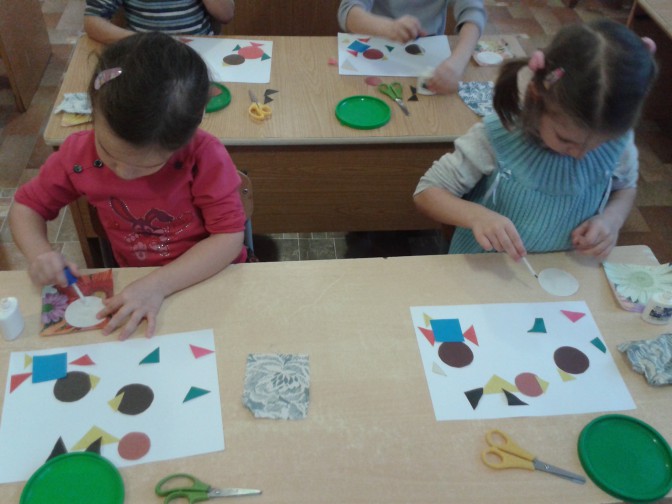
3. Smooth application a napkin from the middle of the details to the edges. And that's what we did.
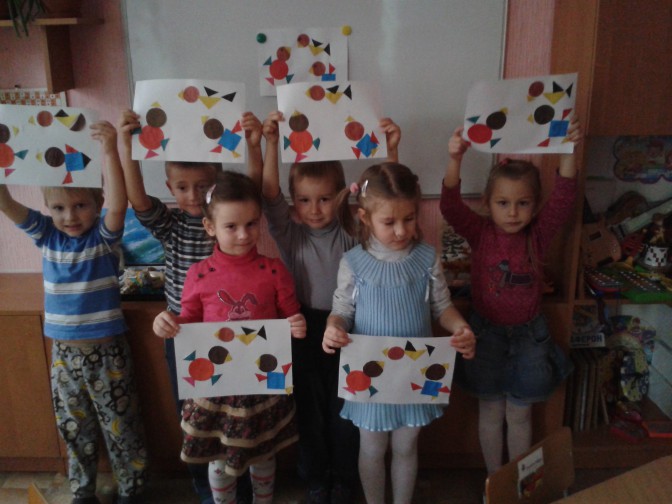
The guys really liked to cut, stick and fantasize.
Publications on the topic:
Application “Bus for animals” medium group Objectives: to consolidate the ability to depict objects from ready-made forms, transfer their structure, hold scissors properly and cut a narrow strip evenly.
On April 12, the whole world celebrates the Day of Aviation and Cosmonautics. This is a special day - on this day in 1961, a citizen of the USSR, Major Yu. A. Gagarin.
Application The average group is 4-5 years old. Theme: Magic Garden. Objective: To learn to create a collective composition, independently determining the content.
From black paper and using a hole punch we make blanks of black dots for ladybug. Cut out an oval from black paper.
Topic: Decorate the cup. Objectives: Educational: to teach to arrange and stick objects in a certain sequence. Developing: secure.
Purpose. Develop the creative abilities of children, the desire to engage in the application. Tasks. Strengthen children's knowledge of the round and oval shape.
We look out the window - it is raining. We remember the cake: Rain, rain, drip and drip, Wet paths. We can not go for a walk - We wet.

Application in preschool
3rd year student 3 courses "DPP" Kashkareva I.A. APPLICATION
From the Latin word "applicatio" - overlaying.
It originated in the XVI century.
A way to create artistic images from various shapes, cut from any material and pasted or sewn onto the appropriate background.
Different materials are used: leather, felt, cloth, birch bark, fur, fabric, straw, paper.

APPLICATION
this is the easiest and most affordable way for children to create artwork that preserves the realistic basis of the image itself;
it is a didactic tool for the development of spatial thinking, fine motor skills of the hand, therefore, the development of speech and intelligence;
a lesson that develops the ability to listen, understand and execute instructions, perform sequential actions, coordinate the work of hands and eyes
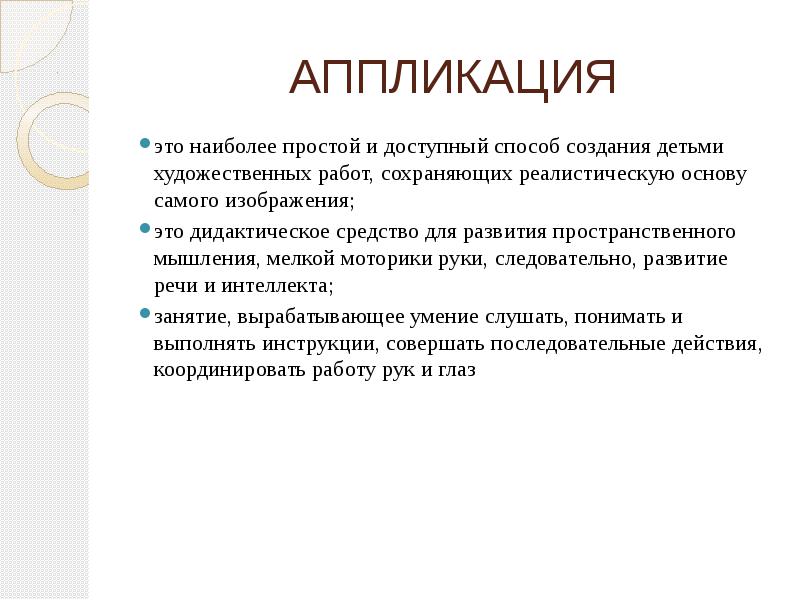
APPLICATION promotes
formation of certain knowledge in children, development of skills, development of skills and personality education
the assimilation of knowledge about the color, structure of objects, their size, plane shape and composition
mastering the knowledge of symmetry and asymmetry
the development of orientation in space and on a limited surface, small muscles of the hands
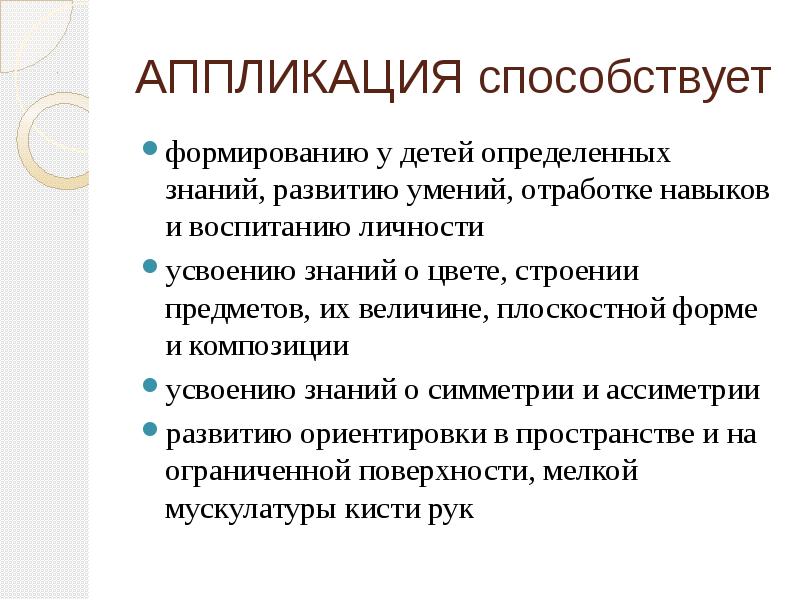
Types of application

Creating a developing environment (a corner of aesthetic activity)
Kashkareva I.A. APPLICATION
From the Latin word "applicatio" - overlaying.
It originated in the XVI century.
A way to create artistic images from various shapes, cut from any material and pasted or sewn onto the appropriate background.
Different materials are used: leather, felt, cloth, birch bark, fur, fabric, straw, paper.

APPLICATION
this is the easiest and most affordable way for children to create artwork that preserves the realistic basis of the image itself;
it is a didactic tool for the development of spatial thinking, fine motor skills of the hand, therefore, the development of speech and intelligence;
a lesson that develops the ability to listen, understand and execute instructions, perform sequential actions, coordinate the work of hands and eyes

APPLICATION promotes
formation of certain knowledge in children, development of skills, development of skills and personality education
the assimilation of knowledge about the color, structure of objects, their size, plane shape and composition
mastering the knowledge of symmetry and asymmetry
the development of orientation in space and on a limited surface, small muscles of the hands

Types of application

Creating a developing environment (a corner of aesthetic activity)
From the Latin word "applicatio" - overlaying.
It originated in the XVI century.
A way to create artistic images from various shapes, cut from any material and pasted or sewn onto the appropriate background.
Different materials are used: leather, felt, cloth, birch bark, fur, fabric, straw, paper.
this is the easiest and most affordable way for children to create artwork that preserves the realistic basis of the image itself;
it is a didactic tool for the development of spatial thinking, fine motor skills of the hand, therefore, the development of speech and intelligence;
a lesson that develops the ability to listen, understand and execute instructions, perform sequential actions, coordinate the work of hands and eyes
formation of certain knowledge in children, development of skills, development of skills and personality education
the assimilation of knowledge about the color, structure of objects, their size, plane shape and composition
mastering the knowledge of symmetry and asymmetry
the development of orientation in space and on a limited surface, small muscles of the hands
White, colored and mixed paper, cardboard
Sets of scissors, glue, brushes, napkins
Colored pencils, felt-tip pens and markers, accessories,
waste material
Selection didactic games
Albums and books for review
Blanks
Stencils
Albums with samples, algorithms, models and schemes
Games with counting sticks
Finger games
Planar geometric mosaic
A set of exercise games and materials for finger
massage 
Corner from isode of activity in preschool
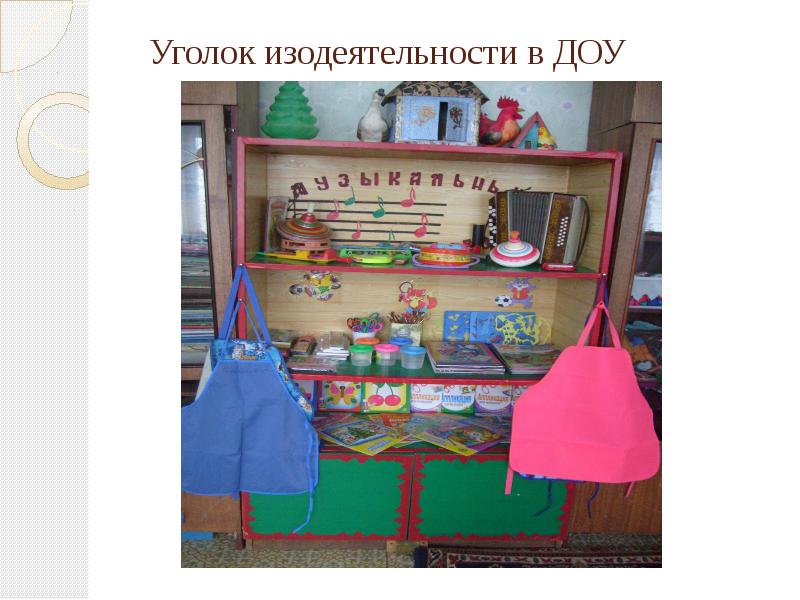
Cutting methods
1. Cutting regular geometric shapes must match 2
cut diagonally
side matches side
diameter corresponds to the side

Cutting methods
cut diagonally
side matches side
diameter corresponds to the side

Cutting methods
cut diagonally
side matches side
diameter corresponds to the side

Cutting methods
side matches side
diameter corresponds to the side

Cutting methods
side matches side
diameter corresponds to the side

Cutting methods
diameter corresponds to the side

Cutting methods
2. Cutting out of double folded paper
Used for cutting objects of symmetrical shapes (leaves, flowers)
3. Cutting out of paper folded several times.
For cutting objects of more complex symmetrical shape
4. Cutting out of accordion folded paper
For cutting several identical shapes and for garlands
5. Cutting in pieces
6. Cutting around the contour
7. Paper breaking 
I younger group (2-3 years)

In the youngest group not providedprogram, but The work of the educator is aimed at preparing the child for mastering a new kind of graphic activity. Children learn: -to lay down the figures in a given order -to make objects of 2-3 parts -to relate them in shape, color, size, spatial arrangement Subjects of employment: “Track for the Bunny”, “House for Masha”, “Balls”, “Pattern”, “Flags”, plot mosaic character: "The sun and the rain", "Hen Ryaba"

2 youngest group (3-4 years)

Tasks
Familiarize children with different properties of paper as a material.
Familiarize with the techniques of laying out and sticking ready-made forms on a sheet of paper.
Learn to navigate on a sheet of paper.
Familiarize with the techniques of working with glue and brush.
To teach the composition of the plot composition of geometric shapes.
Develop hand mobility.


Middle group (4-5 years)

Tasks
Learn to stick the pattern on the base of irregular shape.
Learn to hold the scissors properly and act with them.
Teach the techniques of cutting shapes by cutting corners, cutting circle and oval shapes from a square and a rectangle.
Introduce Paper Cutting Technique
Continue to teach children to stick ready-made forms on the model, make a composition
Continue to develop fine motor hand.

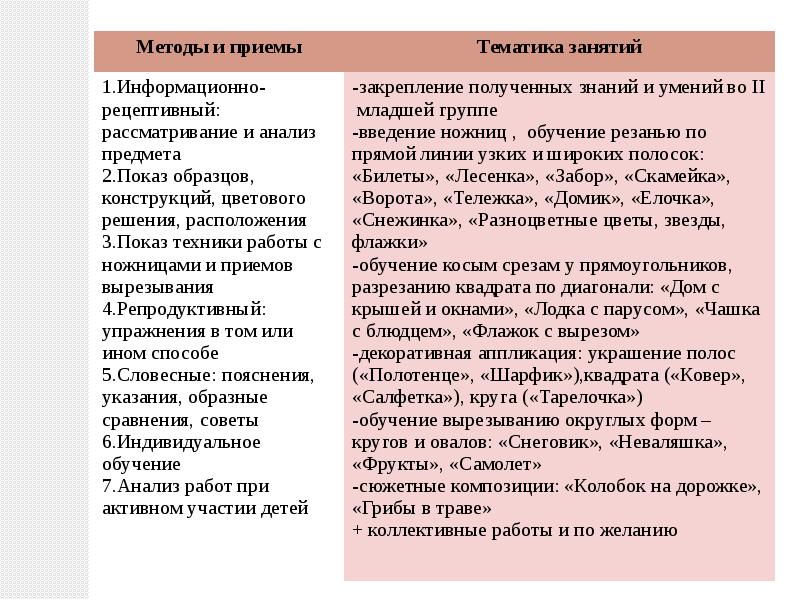
Senior group (5-6 years)

Tasks
To learn to find and select familiar shapes in objects, to distinguish and name a square, rectangle, circle, oval, triangle according to the main features
Refine knowledge about different colors and differentiate them into bright, bright, dark tones
Learn to compare figures by size: high, low, narrow, wide, thick, thin, long, short, above, below, in the middle, behind each other, beside, to the left, to the right
Continue teaching cutting techniques + harmonica cutting and symmetrically
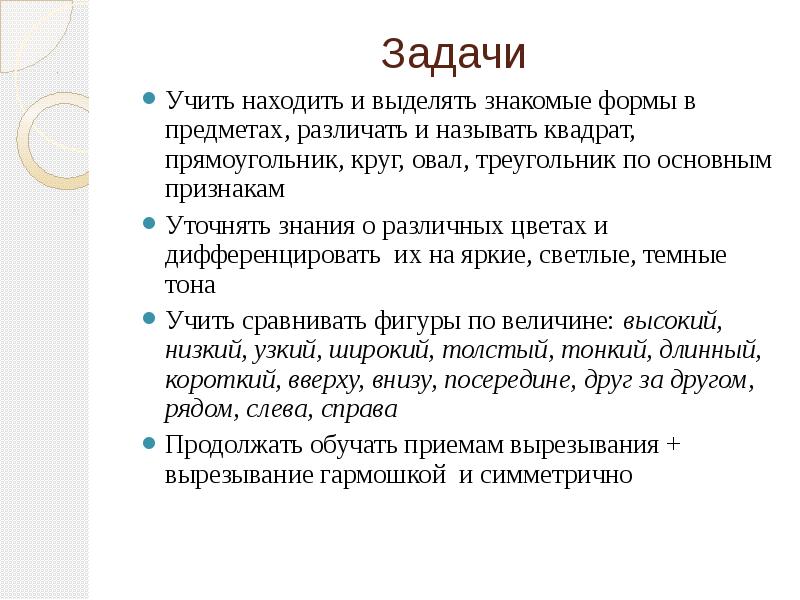

Preparatory group (6-7 years)

Tasks
Continue to clarify the knowledge of children about familiar geometric shapes + polygons with different numbers of angles
Learn to differentiate the shades of the basic spectral tones, distinguish between cold and warm colors, light and dark shades.
Continue to teach orientation on the plane of the sheet of paper + on the contrary, in pairs, on the same level
Learning to draw with scissors - cutting without first drawing a contour line with the transfer of the characteristic features of various silhouettes
To form the ability to independently plan work
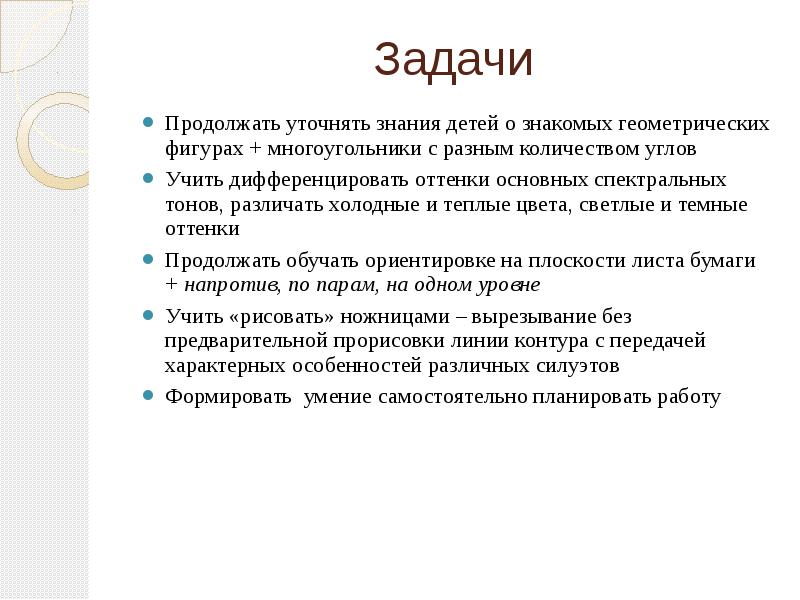
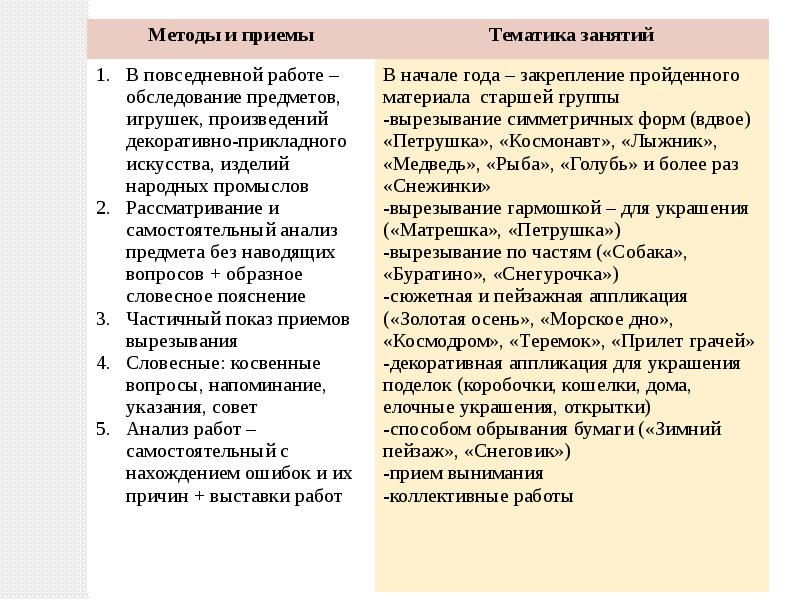
Organization of classes




